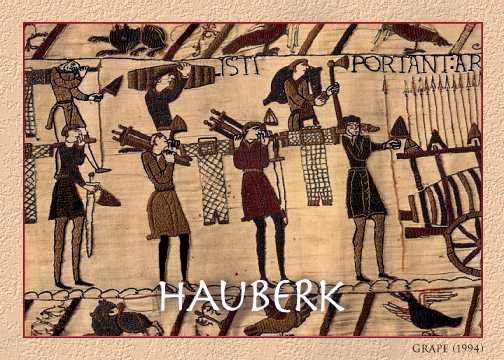
Return to the Battle of Hastings

The Normans and Anglo-Saxons were similarly armed and evenly matched. The difference was the Norman use of mounted knights and many more bowmen, and William's ability to use them in succession.
The Norman knight was protected by a hauberk, a heavy coat of mail comprised of interlinked riveted metal rings. Its Anglo-Saxon equivalent was the byrnie (the only examples of such mail are the corroded lump found at Sutton Hoo and the neck-guard of the Coppergate helmet). As can be seen in the illustration from the Bayeux Tapestry, the hauberk had short sleeves that left the forearms free and a slit in the skirt to facilitate riding. Normally, it extended into a coif or hood over the head, which also was protected by a conical helmet, hammered from a single piece of iron, with a separate noseguard (the men can be seen carrying helmets by the nasal). William also is shown wearing mail leggings called chausses. Sleeves of mail were worn as well.
One also sees the long lance used by the knight and the kite-shaped shield, which had a rounded top and was tapered at the end to protect the legs without rubbing against the flank of the horse. It was held in back by straps and could be slung over the shoulder by a longer strap around the neck. The broad-bladed sword was an aristocratic weapon and not used by the foot soldier, whose typical weapon was the spear.